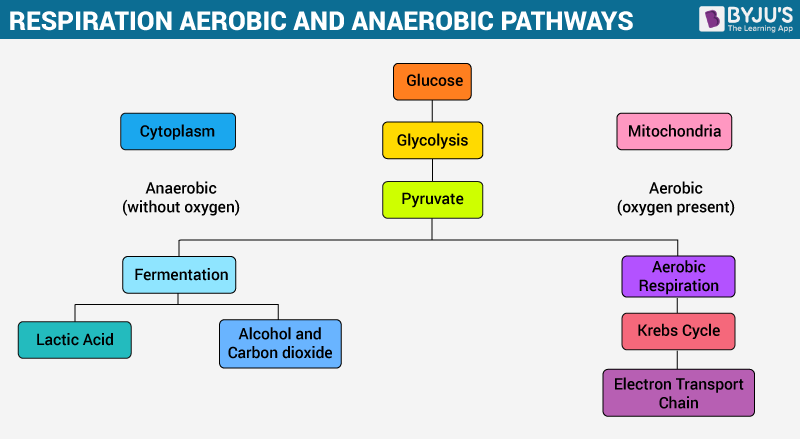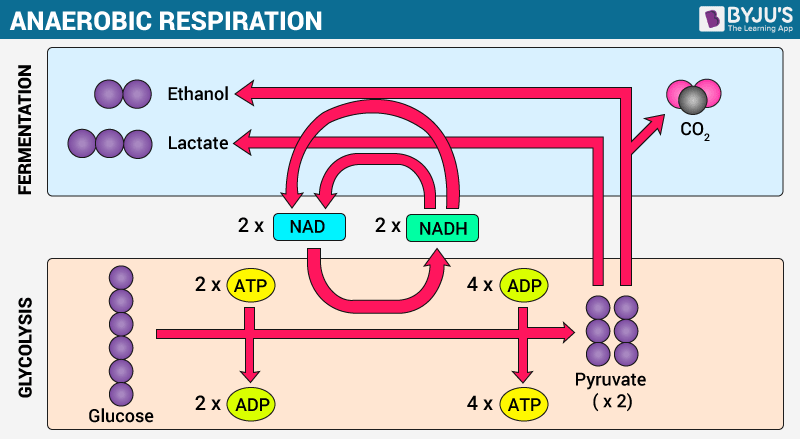Table of Contents
Energy is the driving force of any work. Every cellular activity depends on energy, and food is the source of energy. In cells, cellular respiration is the pathway of yielding energy in the form of adenosine triphosphate (ATP). Both eukaryotic and prokaryotic cells undergo cellular respiration. Depending upon the oxygen demand, cellular respiration is of two types- aerobic and anaerobic respiration.
Types of Cellular Respiration
Aerobic Respiration
Aerobic respiration is the burning or oxidation of glucose in the presence of oxygen to release energy (ATP). The whole process of aerobic respiration takes place in three steps: glycolysis, Krebs’ cycle, and electron transport system. Sites of respiration are cytoplasm and mitochondria.

- Glycolysis: Glycolysis is the lysis or splitting of glucose. During glycolysis, one molecule of 6-carbon compound glucose is broken down into two molecules of 3-carbon pyruvic acid. This occurs in the cytoplasm either in the presence or in the absence of oxygen. Totally, in the end, we get two pyruvic acid molecules, two ATP molecules and two NADH electron carrying molecules.
- Krebs’ cycle: Also known as the tricarboxylic acid cycle (TCA cycle) or the citric acid cycle. The pyruvic acid formed is transferred to the matrix of mitochondria and converted into acetyl CoA. After a series of stages, two molecules of ATP are produced. Also, two compounds- nicotinamide adenine dinucleotide (NADH) and flavin adenine dinucleotide (FADH2) are produced. They help to carry electrons for the next step.
- Electron Transport System and Oxidative Phosphorylation: ETS directly depends on oxygen. Here through a chain of electron carriers such as NADH high-energy electrons are passed on which develops an electron gradient. Eventually, by oxidative phosphorylation ATPase convert ADP to ATP.
At last, in eukaryotes, the total sum of ATP molecules harvested is 36 whereas in prokaryotes it is 38 in single respiration.
Anaerobic Respiration

Anaerobic respiration is a type of cellular respiration where respiration takes place in the absence of oxygen. The process is also called fermentation. They will not enter into the TCA cycle or ETS. Here partial glycolysis results in pyruvic acid. Pyruvic acid undergoes further reduction and gives carbon dioxide and ethanol along with ATP. This is known as alcoholic fermentation.
During anaerobic conditions, inside animal muscle cells, fermentation takes place and produces lactic acid and ATP. This is lactic acid fermentation. The total sum of ATP molecules produced during fermentation is very less as compared to aerobic respiration.
To know more about Respiration In Animals, watch the video given below:

To learn about cellular respiration in detail, visit BYJU’S.
Frequently Asked Questions on Cellular Respiration: Aerobic Vs Anaerobic
What is Aerobic Respiration?
Aerobic respiration is the burning or oxidation of glucose in the presence of oxygen to release energy in the form of ATP.
What is anaerobic respiration?
Anaerobic respiration is a type of cellular respiration where respiration takes place in the absence of oxygen. The process is also called fermentation.
What is TCA cycle?
The tricarboxylic acid [TCA] cycle or Kreb’s cycle is a cyclic pathway that takes in pyruvic acid to release Carbon dioxide and energy.
What is ETS?
The Electron Transport System [ETS] is a chain of electron carriers such as NADH high-energy electrons are passed on which develops an electron gradient.
What is glycolysis?
Glycolysis is a pathway in which one molecule of glucose splits into two molecules of pyruvic acid.

Nice resource.